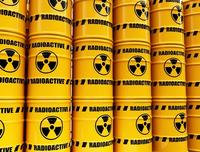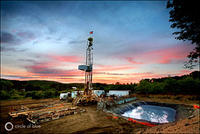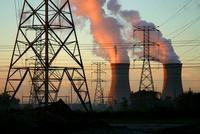-
Safe long-term CO2 storage possible

Since 2004, the German Research Centre for Geosciences (GFZ) has led an international research network to investigate the geological storage of the greenhouse gas (CCS, for carbon capture and storage). GFZ’s scientists say that their work at the Ketzin site, 40 km west of Berlin, has shown that geological CO2 storage on a pilot scale can be done safely and reliably.
-
-
Wireless device converts wasted energy into electric power
Using inexpensive materials configured and tuned to capture microwave signals, researchers have designed a power-harvesting device with efficiency similar to that of modern solar panels. The device wirelessly converts the microwave signal to direct current voltage capable of recharging a cell phone battery or other small electronic device.
-
-
Reducing volume of nuclear waste by 90 percent possible

Engineers have developed a way significantly to reduce the volume of some higher activity wastes, which will reduce the cost of interim storage and final disposal. The researchers have shown that mixing plutonium-contaminated waste with blast furnace slag and turning it into glass reduces its volume by 85-95 percent. It also effectively locks in the radioactive plutonium, creating a stable end product.
-
-
Water shortage hobbles expansion of shale gas drilling

Many point to the large reserves of shale gas as promising U.S. energy independence in the near future. Extracting shale gas, however, requires huge amounts of water, and growing water shortages have already led to conflicts over water use between shale gas developers and farmers. Such conflicts are only going to intensify.
-
-
“Hybrid” nuclear plants could make a dent in carbon emissions

Combining nuclear with artificial geothermal, shale oil, or hydrogen production could help slow climate change, study shows. MIT’s Charles Forsberg proposes marrying a nuclear powerplant with another energy system, which he argues could add up to much more than the sum of its parts.
-
-
Scientists: Shale oil and gas may not be U.S. energy salvation
After ten years of production, shale gas in the United States cannot be considered commercially viable, scientists say. They argue that while the use of hydraulic fracturing and horizontal drilling for “tight oil” is an important contributor to U.S. energy supply, it is not going to result in long-term sustainable production or allow the United States to become a net oil exporter.
-
-
Urban underground water can be used for sustainable energy
Vast energy sources are slumbering below big cities. Sustainable energies for heating in winter and cooling in summer may be extracted from heated groundwater aquifers. Researchers developed an analytical heat flux model and found that increasing heat in the underground is mainly caused by an increase in surface temperatures and heat release from buildings.
-
-
Russia to build floating nuclear power plants

Global warming is opening the Arctic Ocean to shipping – and causing the rapid melting of Arctic ice. Russia says that ship-based nuclear power plants would allow it to provide power to remote cities in Siberia, and provide power to oil and gas drilling operations in the Arctic (about 30 percent of the world’s unclaimed natural gas is in the Arctic, and about, 60 percent of that unclaimed natural gas is in the Russian Arctic). Experts worry about the ability of ship-based nuclear reactor to withstand extreme weather events, or terrorist attacks. The U.S. Army deployed its own floating nuclear reactor – the Sturgis – in the Panama Canal Zone from 1968 to 1976.
-
-
Where should U.S. radioactive waste be buried?
In the United States, about 70,000 metric tons of spent commercial nuclear fuel are located at more than seventy sites in thirty-five states. Shales and other clay-rich (argillaceous) rocks have never been seriously considered for holding America’s spent nuclear fuel, but it is different overseas. France, Switzerland, and Belgium are planning to put waste in tunnels mined out of shale formations, and Canada, Japan, and the United Kingdom are evaluating the idea.
-
-
Burping for power: Tapping cow burps for natural gas
Scientists in Argentina have developed a method to transform the gas created by cows’ digestive systems into fuel. The technique channels the digestive gases from bovine stomach cavities through a tube and into a tank, where the gases, called eruptos (burps) in Spanish, are processed to separate methane from other gases such as carbon dioxide.
-
-
Weatherizing U.S. homes to uniform standard to save $33 billion a year
The U.S. residential sector — 113 million homes — uses about 23 percent of total U.S. source energy annually (source energy includes site energy, the energy consumed by buildings for heating and electricity, as well as the raw energy required to transmit, deliver and produce it). A new study finds that upgrading buildings’ airtightness to a uniform level could achieve as much as $33 billion in annual energy savings.
-
-
U.S. formulates strategy for a new Arctic landscape
U.S. national security officials have become increasingly concerned about the national security implications of an ice-free Arctic. The Arctic will become ice-free during the summer by mid-decade. In a strategy document, the Pentagon says: “Melting sea ice in the Arctic may lead to new opportunities for shipping, tourism, and resource exploration, but the increase in human activity may require a significant increase in operational capabilities in the region in order to safeguard lawful trade and travel and to prevent exploitation of new routes for smuggling and trafficking.”
-
-
U.S. nuclear power industry facing growing challenges
The U.S. nuclear industry is scaling back expectations on the future of the industry, expectations which only a few were soaring. The availability of cheaper energy alternatives, a growing trend toward energy conservation, and renewed safety and health worries as a result of the 2011 Fukushima Daiichi Nuclear Power Plantaccident, are all reasons for why active nuclear plants are being forced to close, and why fewer energy companies are investing in new nuclear plants or upgrading existing ones.
-
-
Renewable fuel standard: mend it, don’t end it
Congress should minimally modify — and not, as petroleum-related interests have increasingly lobbied for, repeal — the Renewable Fuel Standard (RFS), the most comprehensive renewable energy policy in the United States, according to a new paper. The paper argues that RFS mandates merely ought to be adjusted to reflect current and predicted biofuel commercialization realities.
-
-
Sea power: extracting energy from ocean waves

As sources of renewable energy, sun and wind have one major disadvantage: it is not always sunny or windy. Waves in the ocean, on the other hand, are never still. Researchers are now aiming to use waves to produce energy by making use of contact electrification between a patterned plastic nanoarray and water.
-
- All
- Regional
- Water
- Biometrics
- Borders/Immig
- Business
- Cybersecurity
- Detection
- Disasters
- Government
- Infrastructure
- International
- Public health
- Public Safety
- Communication interoperabillity
- Emergency services
- Emergency medical services
- Fire
- First response
- IEDs
- Law Enforcement
- Law Enforcement Technology
- Military technology
- Nonlethal weapons
- Nuclear weapons
- Personal protection equipment
- Police
- Notification /alert systems
- Situational awareness
- Weapons systems
- Sci-Tech
- Sector Reports
- Surveillance
- Transportation
Advertising & Marketing: advertise@newswirepubs.com
Editorial: editor@newswirepubs.com
General: info@newswirepubs.com
2010-2011 © News Wire Publications, LLC News Wire Publications, LLC
220 Old Country Road | Suite 200 | Mineola | New York | 11501
Permissions and Policies
Editorial: editor@newswirepubs.com
General: info@newswirepubs.com
2010-2011 © News Wire Publications, LLC News Wire Publications, LLC
220 Old Country Road | Suite 200 | Mineola | New York | 11501
Permissions and Policies
